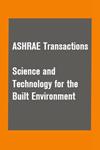Lagrangian particle modeling in the indoor environment: A comparison of RANS and LES turbulence methods (RP-1512)
引用次数: 33
Abstract
Indoor particulate contaminants can be generated in many ways, commonly from human activities, infiltration of HVAC systems, or resuspension from indoor surfaces. Most of these sources are transient and generate nonuniform particle distribution in the space. This study used experimental and numerical methods to investigate the dispersion of three different particle sizes (0.7, 2.5, and 7 μm) emitted from typical source positions. A test room and simplified thermal manikins were employed to mimic a realistic indoor environment, and experimental data were compared with particle modeling using the Lagrangian method coupled with Reynolds averaged Navier-Stokes (RANS) and large eddy simulation (LES) computational fluid dynamics (CFD) turbulence models. Particle dispersion was studied for two ventilation patterns: buoyancy-driven ventilation and well-mixed ventilation. The results provided a comparison of Lagrangian-RANS particle modeling, Lagrangian-LES particle modeling, and experimental data considering nonuniform temporal and spatial particle concentrations. Experimental and modeling results were evaluated with three different metrics: peak normalized concentration at various locations, peak-concentration occurrence time, and mean exposure defined as the averaged concentration in the occupant's breathing zone. The results show that Lagrangian-LES more accurately predicts concentration fluctuation during particle emission. Considering long-term exposure, however, both methods show similar results.室内拉格朗日粒子建模:RANS和LES湍流方法的比较(RP-1512)
室内颗粒污染物可以通过多种方式产生,通常来自人类活动、HVAC系统的渗透或室内表面的再悬浮。这些源大多是瞬态的,在空间上产生不均匀的粒子分布。本研究采用实验和数值方法研究了三种不同粒径(0.7 μm、2.5 μm和7 μm)从典型源位置发射的散射。采用实验室内和简化的热人体模型模拟真实的室内环境,并将实验数据与拉格朗日方法结合Reynolds平均Navier-Stokes (RANS)和大涡模拟(LES)计算流体动力学(CFD)湍流模型的颗粒模型进行了比较。研究了两种通风方式:浮力驱动通风和均匀混合通风。结果提供了拉格朗日- rans粒子模型、拉格朗日- les粒子模型和考虑非均匀时空粒子浓度的实验数据的比较。实验和建模结果用三个不同的指标进行评估:不同地点的峰值标准化浓度、峰值浓度发生时间和平均暴露量(即乘员呼吸区的平均浓度)。结果表明,拉格朗日- les能较准确地预测粒子发射过程中的浓度波动。然而,考虑到长期暴露,两种方法显示出相似的结果。
本文章由计算机程序翻译,如有差异,请以英文原文为准。
求助全文
约1分钟内获得全文
求助全文

 求助内容:
求助内容: 应助结果提醒方式:
应助结果提醒方式:


